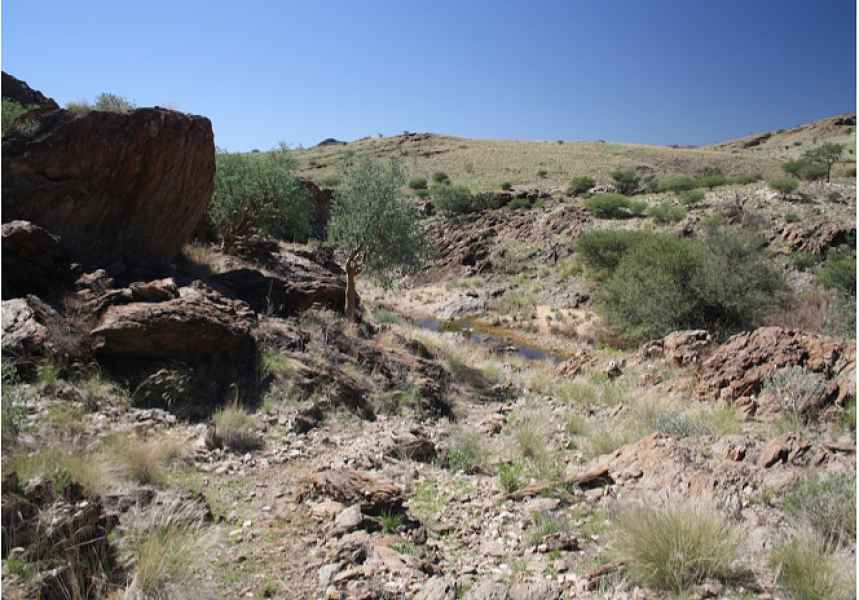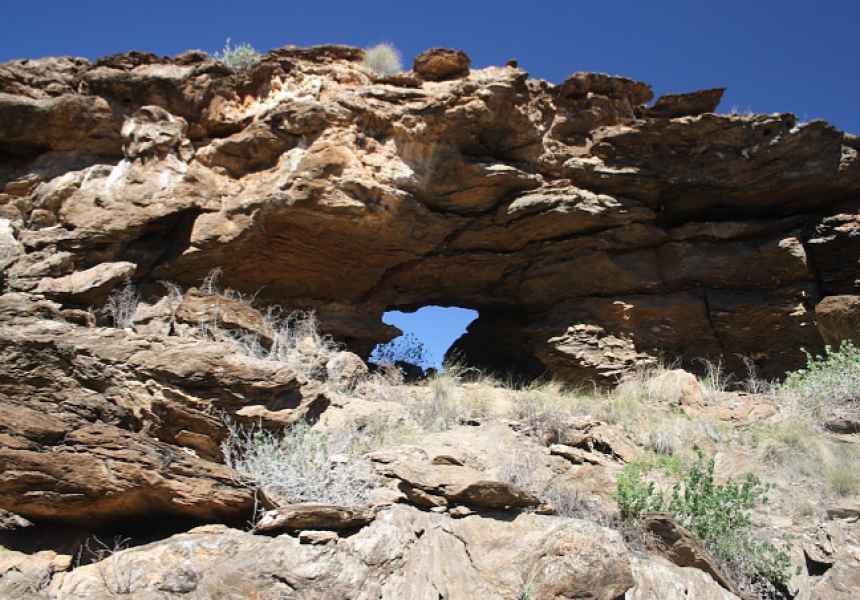Leopard Trail
Easy walking trail through a beautiful rivier to the Springbok pump and back to the farm house.
Time: 2 hours
Description
This easy and not very demanding hike takes us through a beautiful rivir to the Springbok pump and on the farm pad back to the lodge. The trail elates with its beautiful rock formations and the relatively lush vegetation. Often water holes and pools remain long after the rainy season and when the water is high enough, they invite for a swim. Tracks in the sand give evidence of their nightly visitors. With some luck we will find the footprints of the leopard who gives the trail its name. During the daytime he hides from us and is usually no threat to us. Other than the cats, we should be able to see plenty of birds during the day, drinking water or nesting in the steep banks. To the end of the trail we enjoy a relaxed walk on a farmpad with stunning views over the undulating hills back to the lodge. We leave the lodge in a southerly direction on the farm pad. Shortly after the gate we take a leftt turn, passing the water hole until we reach a pile of white quartz stones with a sign saying "Leopard Trail". We leave the pad here and follow the marked path down into the river. There we turn right and follow the course of the river. Right at the beginning we encounter a rock threshold under which a pool of water can be found almost the whole year. To avoid this pool we keep on the left stream side where we can easily pass the threshold and the pool with dry feet.
Immediately after that, walking will be easy again and we can enjoy the vegetation in the riverbed. Some balsam trees (Commiphora glaucescens) and African chestnuts (Sterculia africana) grow at the steep riverbed.
In the riverbed we find Swarthaak, Wag-E-Bitje and occasionally Camelthorn (Acacia erioloba). After the rainy season various herbs and shrubs bloom, some with spectacular flowers like Cleome, others small and inconspicuous, revealing their beauty only on a second view
Shortly thereafter, the riverbed narrows into a gorge, the canyon walls become steeper and overhanging. Birds nest in the crevices and caves and dassis betray themselves by the white remains of their excrements covering the rocks.
After 30 minutes the riverbed narrows again. To the left behind us we can see an nice hole in the wall and not long afterwards, we need to make our way through a narrow and steep passage at whose end a waterhole waits. We have to climb around it on an steep but grippy rock wall. Soon we come to the confluence of our river with another one where we keep to the right. Overhead, above the imposing rock walls we can already see the solar paneels of the Springbok pump. But for now we have to follow the river that leads gently around the ridge with the pump. Shortly after the bend the remains of an old pump and water tank appear on the right river bank. Here we exit the river to the right, pass the old pump to the left and soon come across an old pad that leads us uphill to the Springbok pump. From there we follow the easily recognizable farm pad over the gentle hills covered with gleaming feather grass (Stipagrostis) towards the farm house. Our view wanders to the right, to the impressive mountains of the escarpment and to the left to Mount Rostock. Soon we spot the majestic Gamsberg, in front the Poviansberg and the Hill of the Campsites. After another 20 minutes the lodge can be seen, rest and cold drinks a few minutes away.
After a wonderful walking experience we relax in the shade of the lapa, enjoying a cold beer or Savanna or cooling down with a swim in the inviting pool.
What you should bear in mind on your walk
Before starting your walk you should notify the reception about your intended trail and when you expect to be back. Do not forget to inform the reception after you got back to avoid a possible search. And keep in mind, that there is no cellular reception in most parts of the area.
Never leave the marked path and do not try to shortcut the trail. The terrain with its deeply cut rivers and ravines is confusing and orientation and progress off the trails and pads will be strenuous and difficult. Especially during summer temperatures can be very high. Even in winter temperatures often rise over 30° and there will be almost no shade available on your walk. Always take enough water with you and expect the walk to be strenuous. Pay attention to sufficient sun protection and good footwear.
During the rainy season the rivers can still run, and parts of the trail may be flooded and impassable. Keep this in mind and ask at the reception about the current situation. They will provide you with valuable information and useful hints. On your walk you will most certainly come across some game. Mostly this will be zebras, kudus, oryx or dassis and duikers. Although there are also predators like hyena, rooikat, leopard and even cheetah, they are rather shy and will avoid you. If you are lucky, you will recognize their tracks in the sand. There are also snakes and scorpions, but these too will hardly be seen. Nonetheless, always keep in mind, that you are in a wilderness. Never deliberately disturb the game, do not take or remove stones or plants. Respect nature and walk with open eyes. Leave nothing but your footprints. If you consider this, your walk will be a unique experience.







